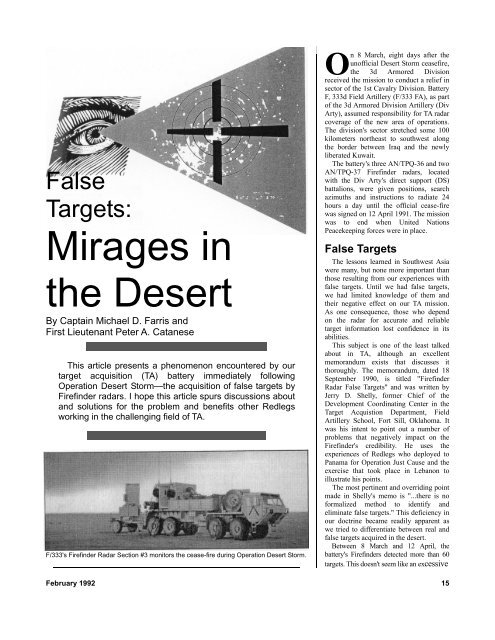February - Fort Sill - U.S. Army
February - Fort Sill - U.S. Army
February - Fort Sill - U.S. Army
Create successful ePaper yourself
Turn your PDF publications into a flip-book with our unique Google optimized e-Paper software.
False<br />
Targets:<br />
Mirages in<br />
the Desert<br />
By Captain Michael D. Farris and<br />
First Lieutenant Peter A. Catanese<br />
This article presents a phenomenon encountered by our<br />
target acquisition (TA) battery immediately following<br />
Operation Desert Storm—the acquisition of false targets by<br />
Firefinder radars. I hope this article spurs discussions about<br />
and solutions for the problem and benefits other Redlegs<br />
working in the challenging field of TA.<br />
F/333's Firefinder Radar Section #3 monitors the cease-fire during Operation Desert Storm.<br />
On 8 March, eight days after the<br />
unofficial Desert Storm ceasefire,<br />
the 3d Armored Division<br />
received the mission to conduct a relief in<br />
sector of the 1st Cavalry Division. Battery<br />
F, 333d Field Artillery (F/333 FA), as part<br />
of the 3d Armored Division Artillery (Div<br />
Arty), assumed responsibility for TA radar<br />
coverage of the new area of operations.<br />
The division's sector stretched some 100<br />
kilometers northeast to southwest along<br />
the border between Iraq and the newly<br />
liberated Kuwait.<br />
The battery's three AN/TPQ-36 and two<br />
AN/TPQ-37 Firefinder radars, located<br />
with the Div Arty's direct support (DS)<br />
battalions, were given positions, search<br />
azimuths and instructions to radiate 24<br />
hours a day until the official cease-fire<br />
was signed on 12 April 1991. The mission<br />
was to end when United Nations<br />
Peacekeeping forces were in place.<br />
False Targets<br />
The lessons learned in Southwest Asia<br />
were many, but none more important than<br />
those resulting from our experiences with<br />
false targets. Until we had false targets,<br />
we had limited knowledge of them and<br />
their negative effect on our TA mission.<br />
As one consequence, those who depend<br />
on the radar for accurate and reliable<br />
target information lost confidence in its<br />
abilities.<br />
This subject is one of the least talked<br />
about in TA, although an excellent<br />
memorandum exists that discusses it<br />
thoroughly. The memorandum, dated 18<br />
September 1990, is titled "Firefinder<br />
Radar False Targets" and was written by<br />
Jerry D. Shelly, former Chief of the<br />
Development Coordinating Center in the<br />
Target Acquistion Department, Field<br />
Artillery School, <strong>Fort</strong> <strong>Sill</strong>, Oklahoma. It<br />
was his intent to point out a number of<br />
problems that negatively impact on the<br />
Firefinder's credibility. He uses the<br />
experiences of Redlegs who deployed to<br />
Panama for Operation Just Cause and the<br />
exercise that took place in Lebanon to<br />
illustrate his points.<br />
The most pertinent and overriding point<br />
made in Shelly's memo is "...there is no<br />
formalized method to identify and<br />
eliminate false targets." This deficiency in<br />
our doctrine became readily apparent as<br />
we tried to differentiate between real and<br />
false targets acquired in the desert.<br />
Between 8 March and 12 April, the<br />
battery's Firefinders detected more than 60<br />
targets. This doesn't seem like an excessive<br />
<strong>February</strong> 1992 15
















